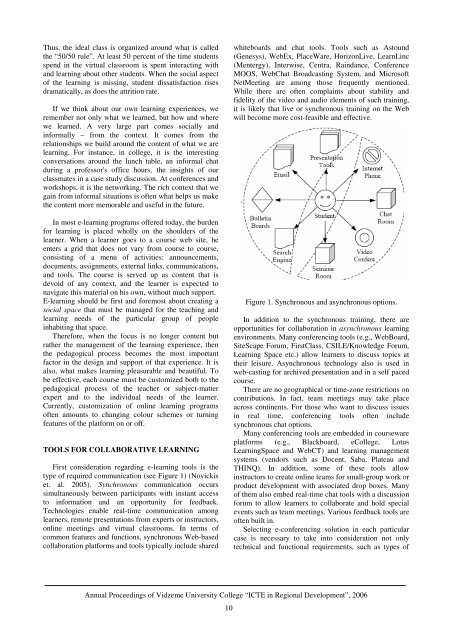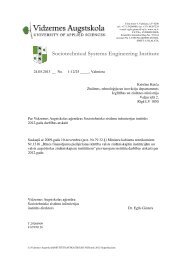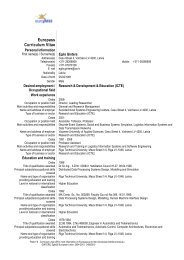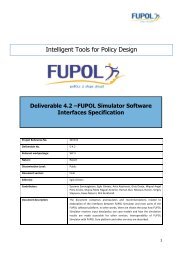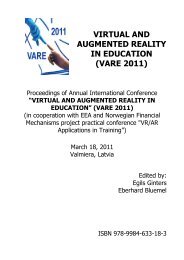Thus, the ideal class is organized around what is calledthe “50/50 rule”. At least 50 percent of the time studentsspend <strong>in</strong> the virtual classroom is spent <strong>in</strong>teract<strong>in</strong>g withand learn<strong>in</strong>g about other students. When the social aspectof the learn<strong>in</strong>g is miss<strong>in</strong>g, student dissatisfaction risesdramatically, as does the attrition rate.If we th<strong>in</strong>k about our own learn<strong>in</strong>g experiences, weremember not only what we learned, but how and wherewe learned. A very large part comes socially and<strong>in</strong>formally – from the context. It comes from therelationships we build around the content of what we arelearn<strong>in</strong>g. For <strong>in</strong>stance, <strong>in</strong> college, it is the <strong>in</strong>terest<strong>in</strong>gconversations around the lunch table, an <strong>in</strong>formal chatdur<strong>in</strong>g a professor's office hours, the <strong>in</strong>sights of ourclassmates <strong>in</strong> a case study discussion. At conferences andworkshops, it is the network<strong>in</strong>g. The rich context that wega<strong>in</strong> from <strong>in</strong>formal situations is often what helps us makethe content more memorable and useful <strong>in</strong> the future.In most e-learn<strong>in</strong>g programs offered today, the burdenfor learn<strong>in</strong>g is placed wholly on the shoulders of thelearner. When a learner goes to a course web site, heenters a grid that does not vary from course to course,consist<strong>in</strong>g of a menu of activities: announcements,documents, assignments, external l<strong>in</strong>ks, communications,and tools. The course is served up as content that isdevoid of any context, and the learner is expected tonavigate this material on his own, without much support.E-learn<strong>in</strong>g should be first and foremost about creat<strong>in</strong>g asocial space that must be managed for the teach<strong>in</strong>g andlearn<strong>in</strong>g needs of the particular group of people<strong>in</strong>habit<strong>in</strong>g that space.Therefore, when the focus is no longer content butrather the management of the learn<strong>in</strong>g experience, thenthe pedagogical process becomes the most importantfactor <strong>in</strong> the design and support of that experience. It isalso, what makes learn<strong>in</strong>g pleasurable and beautiful. Tobe effective, each course must be customized both to thepedagogical process of the teacher or subject-matterexpert and to the <strong>in</strong>dividual needs of the learner.Currently, customization of onl<strong>in</strong>e learn<strong>in</strong>g programsoften amounts to chang<strong>in</strong>g colour schemes or turn<strong>in</strong>gfeatures of the platform on or off.TOOLS FOR COLLABORATIVE LEARNINGFirst consideration regard<strong>in</strong>g e-learn<strong>in</strong>g tools is thetype of required communication (see Figure 1) (Novickiset. al. 2005). Synchronous communication occurssimultaneously between participants with <strong>in</strong>stant accessto <strong>in</strong><strong>format</strong>ion and an opportunity for feedback.Technologies enable real-time communication amonglearners, remote presentations from experts or <strong>in</strong>structors,onl<strong>in</strong>e meet<strong>in</strong>gs and virtual classrooms. In terms ofcommon features and functions, synchronous Web-basedcollaboration platforms and tools typically <strong>in</strong>clude sharedwhiteboards and chat tools. Tools such as Astound(Genesys), WebEx, PlaceWare, HorizonLive, LearnL<strong>in</strong>c(Mentergy), Interwise, Centra, Ra<strong>in</strong>dance, ConferenceMOOS, WebChat Broadcast<strong>in</strong>g System, and MicrosoftNetMeet<strong>in</strong>g are among those frequently mentioned.While there are often compla<strong>in</strong>ts about stability andfidelity of the video and audio elements of such tra<strong>in</strong><strong>in</strong>g,it is likely that live or synchronous tra<strong>in</strong><strong>in</strong>g on the Webwill become more cost-feasible and effective.Figure 1. Synchronous and asynchronous options.In addition to the synchronous tra<strong>in</strong><strong>in</strong>g, there areopportunities for collaboration <strong>in</strong> asynchronous learn<strong>in</strong>genvironments. Many conferenc<strong>in</strong>g tools (e.g., WebBoard,SiteScape Forum, FirstClass, CSILE/Knowledge Forum,Learn<strong>in</strong>g Space etc.) allow learners to discuss topics attheir leisure. Asynchronous technology also is used <strong>in</strong>web-cast<strong>in</strong>g for archived presentation and <strong>in</strong> a self pacedcourse.There are no geographical or time-zone restrictions oncontributions. In fact, team meet<strong>in</strong>gs may take placeacross cont<strong>in</strong>ents. For those who want to discuss issues<strong>in</strong> real time, conferenc<strong>in</strong>g tools often <strong>in</strong>cludesynchronous chat options.Many conferenc<strong>in</strong>g tools are embedded <strong>in</strong> coursewareplatforms (e.g., Blackboard, eCollege, LotusLearn<strong>in</strong>gSpace and WebCT) and learn<strong>in</strong>g managementsystems (vendors such as Docent, Saba, Plateau andTHINQ). In addition, some of these tools allow<strong>in</strong>structors to create onl<strong>in</strong>e teams for small-group work orproduct development with associated drop boxes. Manyof them also embed real-time chat tools with a discussionforum to allow learners to collaborate and hold specialevents such as team meet<strong>in</strong>gs. Various feedback tools areoften built <strong>in</strong>.Select<strong>in</strong>g e-conferenc<strong>in</strong>g solution <strong>in</strong> each particularcase is necessary to take <strong>in</strong>to consideration not onlytechnical and functional requirements, such as types ofAnnual <strong>Proceed<strong>in</strong>gs</strong> of Vidzeme University College “ICTE <strong>in</strong> Regional Development”, 200610
materials to be presented and which services will berequired - slide presentation, stream<strong>in</strong>g audio, documentshar<strong>in</strong>g, etc., but also organizational and f<strong>in</strong>ancialrequirements and constra<strong>in</strong>ts.WEB-BASED ITSThere are a number of known advantages of webbasedlearn<strong>in</strong>g systems, <strong>in</strong>clud<strong>in</strong>g benefits like time andplace flexible, cost effective, 24/7 available, learnercentredetc. Tak<strong>in</strong>g <strong>in</strong>to account the importance of social<strong>in</strong>teraction to learn<strong>in</strong>g, so called collaborative learn<strong>in</strong>gseems to be very promis<strong>in</strong>g development area.Collaborative learn<strong>in</strong>g means that knowledge is notsometh<strong>in</strong>g that is “delivered” to students, but rathersometh<strong>in</strong>g that emerges from active dialogue amongthose who seek to understand and apply conceptstechniques. Accord<strong>in</strong>g to description above, the ma<strong>in</strong>important components of collaborative learn<strong>in</strong>g <strong>in</strong> webbasedenvironment is how to realize social context, grouplearn<strong>in</strong>g process, communication each other(collaboration), and performance evaluation.The architecture might <strong>in</strong>clude both client and servercomponents. The client presents the <strong>in</strong><strong>format</strong>ion to thestudent and the server keeps track of and structures the<strong>in</strong><strong>format</strong>ion to be delivered to the student (see Figure 2).Individuals use web browsers on client computers (users’computers) to run ITS modules resid<strong>in</strong>g on servercomputers. Normally, a desktop computer, workstation,laptop computer, PDA (Personal Digital Assistant), oreven cell phone can be used as a client computer.Therefore, the software on the student’s computer mustbe platform <strong>in</strong>dependent.Based on client-server architecture, the learn<strong>in</strong>gmodels of ITS programs can be divided three differenttypes: client-based learn<strong>in</strong>g, distributed learn<strong>in</strong>g, andserver-based learn<strong>in</strong>g.In client-based learn<strong>in</strong>g, learn<strong>in</strong>g activities and course<strong>in</strong>structional content are usually operated <strong>in</strong> clientcomputers; <strong>in</strong>dividuals do not need to <strong>in</strong>teract withservers frequently. In distributed learn<strong>in</strong>g, some learn<strong>in</strong>gactivities and <strong>in</strong>structional content are based on clientcomputers and others are run <strong>in</strong> servers.This means that client computers have wholeopportunities to handle learn<strong>in</strong>g activities and contents.In server-based learn<strong>in</strong>g, both learn<strong>in</strong>g activities andcourse <strong>in</strong>structional content are usually run <strong>in</strong> servers,<strong>in</strong>dividual computers only are used as Web browsers.This means learners have more chances tocommunicate with other learners or <strong>in</strong>structors throughserver computers.In web-based ITSs, the goals are classroom<strong>in</strong>dependence and platform <strong>in</strong>dependence of the teach<strong>in</strong>gand learn<strong>in</strong>g process, <strong>in</strong>teractivity and adaptively. Theidea is that ITS application <strong>in</strong>stalled at one server can beused by thousands of learners all over the world who areequipped with any k<strong>in</strong>d of Internet-connected computer.This is, however, far more difficult than just putt<strong>in</strong>g aweb-based course on a server and let remote learnersplay with it.In order to be useful to <strong>in</strong>dividual learners, web-basedITSs must be adaptive, s<strong>in</strong>ce when learn<strong>in</strong>g from a webtutorthere is often no colleague or a teacher around toprovide assistance as <strong>in</strong> a normal classroom situation.CONCLUSIONSEmerg<strong>in</strong>g research shows that learn<strong>in</strong>g isfundamentally both social and experiential. Intelligenttutor<strong>in</strong>g systems <strong>in</strong>tegrated <strong>in</strong>to web-based environmentcan enhance its efficiency and flexibility and has greatpotentials <strong>in</strong> facilitation of collaborative learn<strong>in</strong>g.Collaborative Intelligent Tutor<strong>in</strong>g System (CITS)should be able to provide an environment where thestudent can <strong>in</strong>teract with one or more, simulatedcollaborative partners and/or fellow students, to progresstowards a common goal of learn<strong>in</strong>g.Figure 2. Architecture for the web-based ITS.To overcome problems result<strong>in</strong>g from the <strong>in</strong>creas<strong>in</strong>gcomplexity of human-computer <strong>in</strong>teraction adaptive user<strong>in</strong>terfaces are a promis<strong>in</strong>g attempt.Annual <strong>Proceed<strong>in</strong>gs</strong> of Vidzeme University College “ICTE <strong>in</strong> Regional Development”, 200611
- Page 1 and 2: ISBN 9984-633-03-9Annual Proceeding
- Page 3 and 4: “Development of Creative Human -
- Page 5 and 6: TABLE OF CONTENTSINTELLIGENT SYSTEM
- Page 7 and 8: INTELLIGENT SYSTEM FOR LEARNERS’
- Page 9 and 10: LEARNER 1GROUP OF HUMAN AGENTSLEARN
- Page 11 and 12: QuantityQuantityFigure 6. Distribut
- Page 13 and 14: LEARNERStructure of theconcept mapL
- Page 15: WEB-BASED INTELLIGENT TUTORING SYST
- Page 19 and 20: INFORMATION TECHNOLOGIES AND E-LEAR
- Page 21 and 22: correspondence with the course aim
- Page 23 and 24: projects and through IT. Hence, it
- Page 25 and 26: APPLICATION OF MODELING METHODS IN
- Page 27 and 28: can support configuration managemen
- Page 29 and 30: The EKD is one of the Enterprise mo
- Page 31 and 32: CHANGES TO TRAINING AND PERSPECTIVE
- Page 33 and 34: or an end, yet none of these attitu
- Page 35 and 36: make decisions. It cannot be volunt
- Page 37 and 38: logs), data and video conferencing
- Page 39 and 40: Ability to follow user’s multi-ta
- Page 41 and 42: CONCLUSIONSEDUSA method gives us a
- Page 43 and 44: in successful SD. Given this situat
- Page 45 and 46: SPATIAL INFORMATIONFor the visualis
- Page 47 and 48: MOBILE TECHNOLOGIES USE IN SERVICES
- Page 49 and 50: learning environment (Learning Mana
- Page 51 and 52: ago only some curricula on Logistic
- Page 53 and 54: The Web-based version can be access
- Page 55 and 56: Web-portal, which incorporates diff
- Page 57 and 58: DO INTELLIGENT OBJECTS AUTOMATICALL
- Page 59 and 60: Table 1. Examples for introducing R
- Page 61 and 62: workable influencing of the process
- Page 63 and 64: are handed over to the objects and
- Page 65 and 66: • Basic processes, such as wareho
- Page 67 and 68:
THE ECR E-COACH: A VIRTUAL COACHING
- Page 69 and 70:
participating in the workshops and
- Page 71 and 72:
• Assessment modules enable indiv
- Page 73 and 74:
with pictures and illustrated graph
- Page 75 and 76:
ECR Question Banknumber category su
- Page 77 and 78:
educational programme that follows
- Page 79 and 80:
DEVELOPMENT OF WEB BASED GRAVITY MO
- Page 81 and 82:
These results of a model require a
- Page 83 and 84:
CONCLUSIONSThe main goal of work ha
- Page 85 and 86:
dimension and included within any o
- Page 87 and 88:
• Resources sharing by providing
- Page 89 and 90:
Pursuant to the guidelines of elect
- Page 91 and 92:
tariffs of regulated services have
- Page 93 and 94:
INFORMATION TECHNOLOGY FOR MOTIVATI
- Page 95 and 96:
difficult to predict when and for w
- Page 97 and 98:
Listeners' workon the WebListenersS
- Page 99 and 100:
PERSPECTIVES OF WEB PAGE AND E-MAIL
- Page 101 and 102:
INCREASE IN THE NUMBER OF INTERNETU
- Page 103 and 104:
tourism accommodations (home pages
- Page 105 and 106:
interactive relationships with clie
- Page 107 and 108:
• The data obtained by the resear
- Page 109 and 110:
Central Statistical Bureau of Latvi
- Page 111 and 112:
departures for 1995 are taken from
- Page 113 and 114:
120100maximumworldminimum806040200-
- Page 115 and 116:
140120maximumworldminimum1008060402
- Page 117 and 118:
would be a promising extension. Cur
- Page 119 and 120:
AN OVERVIEW OF THE AGENT − BASED
- Page 121 and 122:
Suitability for social system simul
- Page 123 and 124:
6. MASONDescription:MASON is a fast
- Page 125 and 126:
Suitability for social system simul
- Page 127 and 128:
could be bad particularly when over
- Page 129 and 130:
(for 10 repeat &| CCar[]->runfor);P
- Page 131 and 132:
• Streaming audio• Collaboratio
- Page 133 and 134:
NECESSITY OF NEW LAYERED APPROACH T
- Page 135 and 136:
Up to now, there has only been limi
- Page 137 and 138:
aaaaa6= −aa2,1 = − a0,3226= −
- Page 139 and 140:
∂ u∂x∂ u∂y2 2+ b = 02 2wher
- Page 141 and 142:
a6,3= −2030a4,5−130a4,3- - - -
- Page 143 and 144:
0,10,20,30,4( )Mag x y y Ge wx2, =
- Page 145 and 146:
Example 1. To understand better the
- Page 147 and 148:
Therefore, further the following co
- Page 149 and 150:
SOLUTION OF THE THREE-DIMENSIONALEQ
- Page 151 and 152:
Mag1, m , m , m1 2 3= mm1 m2m32 2 2
- Page 153 and 154:
MagMag0, m , m , m1 2 31, m , m , m
- Page 155:
CONCLUSIONSThe basic content of thi


